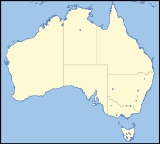
Lake Eildon National Park
Encyclopedia
Lake Eildon National Park is a national park
in Victoria
(Australia
) in the northern foothills of Victoria's Central Highlands, 111 km northeast of Melbourne. The 277.5 km² park abuts the shores of Lake Eildon
.
to provide irrigation water for the Goulburn Valley. An area of 2670 ha that wasn’t flooded was declared Fraser National Park in 1957. An area of 240 km² of state forest adjacent to the lake was reserved as Eildon State Park in 1980 to protect the catchment of Lake Eildon. In 1997, the two parks were combined to create Lake Eildon National Park.
The park includes a number of mine shafts related to Victoria’s gold rush of the 1860s. The park also contains relics from early pastoral use.
The park’s known native fauna includes 34 species of mammals, 89 birds, 17 reptiles, 10 amphibians and three freshwater fish. Threatened fauna recorded in the park include the Brush-tailed Phascogale and Spotted Tree-Frog. Eastern Grey Kangaroos are very common in the park’s camping areas.
National park
A national park is a reserve of natural, semi-natural, or developed land that a sovereign state declares or owns. Although individual nations designate their own national parks differently A national park is a reserve of natural, semi-natural, or developed land that a sovereign state declares or...
in Victoria
Victoria (Australia)
Victoria is the second most populous state in Australia. Geographically the smallest mainland state, Victoria is bordered by New South Wales, South Australia, and Tasmania on Boundary Islet to the north, west and south respectively....
(Australia
Australia
Australia , officially the Commonwealth of Australia, is a country in the Southern Hemisphere comprising the mainland of the Australian continent, the island of Tasmania, and numerous smaller islands in the Indian and Pacific Oceans. It is the world's sixth-largest country by total area...
) in the northern foothills of Victoria's Central Highlands, 111 km northeast of Melbourne. The 277.5 km² park abuts the shores of Lake Eildon
Lake Eildon
Lake Eildon is the impoundment created by Eildon Weir on the Goulburn River in southern Victoria, Australia. At 3,334,158 megalitres when full, it contains six times as much water as Sydney Harbour and is the second largest water storage in Victoria after Dartmouth Dam...
.
History
In the 1950s, the Victorian State Government purchased farming properties along the Goulburn and Delatite rivers for the construction of Lake EildonLake Eildon
Lake Eildon is the impoundment created by Eildon Weir on the Goulburn River in southern Victoria, Australia. At 3,334,158 megalitres when full, it contains six times as much water as Sydney Harbour and is the second largest water storage in Victoria after Dartmouth Dam...
to provide irrigation water for the Goulburn Valley. An area of 2670 ha that wasn’t flooded was declared Fraser National Park in 1957. An area of 240 km² of state forest adjacent to the lake was reserved as Eildon State Park in 1980 to protect the catchment of Lake Eildon. In 1997, the two parks were combined to create Lake Eildon National Park.
Cultural heritage
The Goulburn River Valley supported a population of hundreds of members of the Taungaurung Aboriginal people. Cultural sites belonging to these people would have been flooded with the creation of Lake Eildon.The park includes a number of mine shafts related to Victoria’s gold rush of the 1860s. The park also contains relics from early pastoral use.
Geology
The park is mountainous, with peaks up to 900 m, and includes the edge of the Cerberean Caldera, a huge circular volcano around 27 km across which was active around 380 million years ago. The caldera is evident in a few places as granite outcrops.Flora and fauna
The park’s vegetation is generally dry, open eucalypt forest with areas of riparian forest and montane forest. Main eucalypt species are stringybarks, peppermints, Red Box and Candlebark with areas of Mountain Ash and Blue Gum.The park’s known native fauna includes 34 species of mammals, 89 birds, 17 reptiles, 10 amphibians and three freshwater fish. Threatened fauna recorded in the park include the Brush-tailed Phascogale and Spotted Tree-Frog. Eastern Grey Kangaroos are very common in the park’s camping areas.

